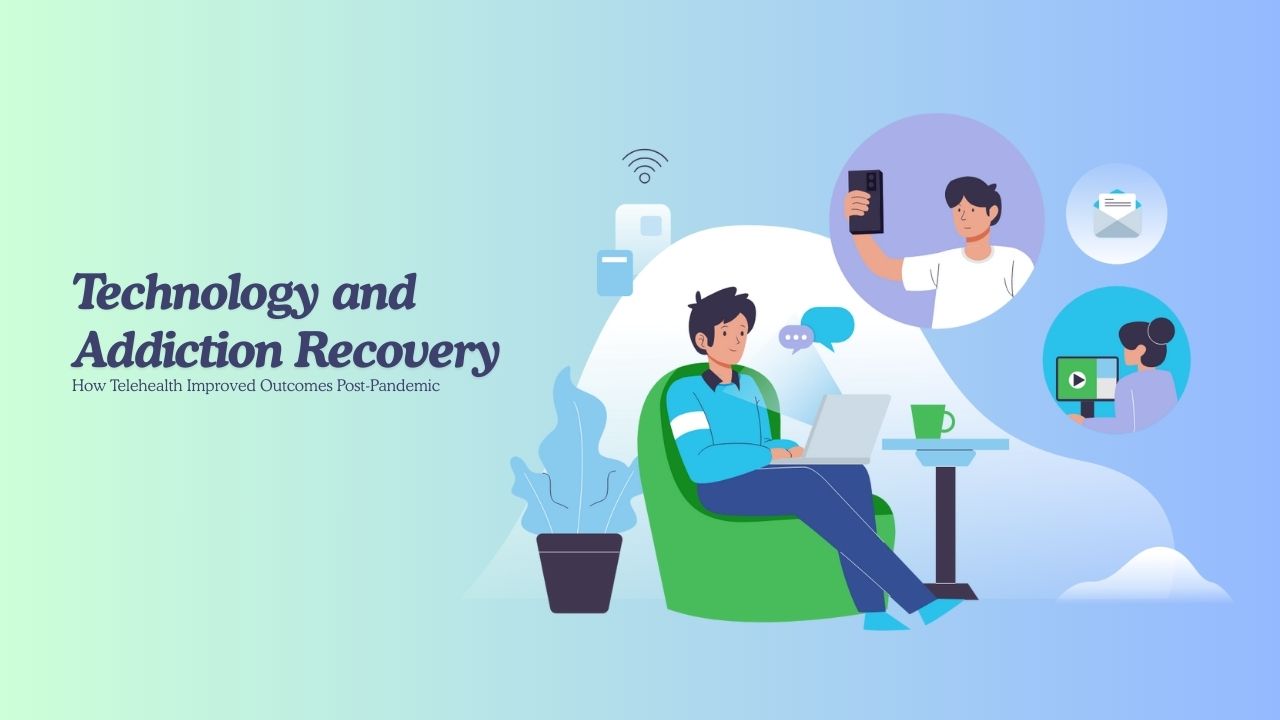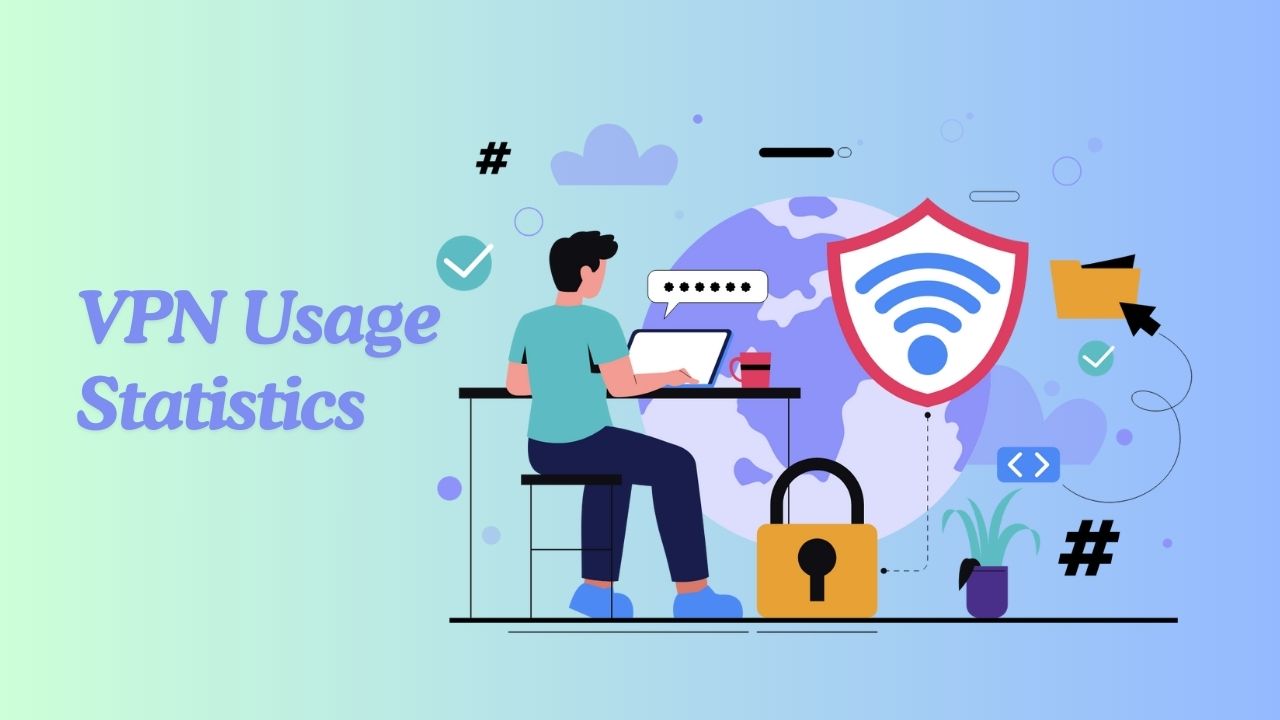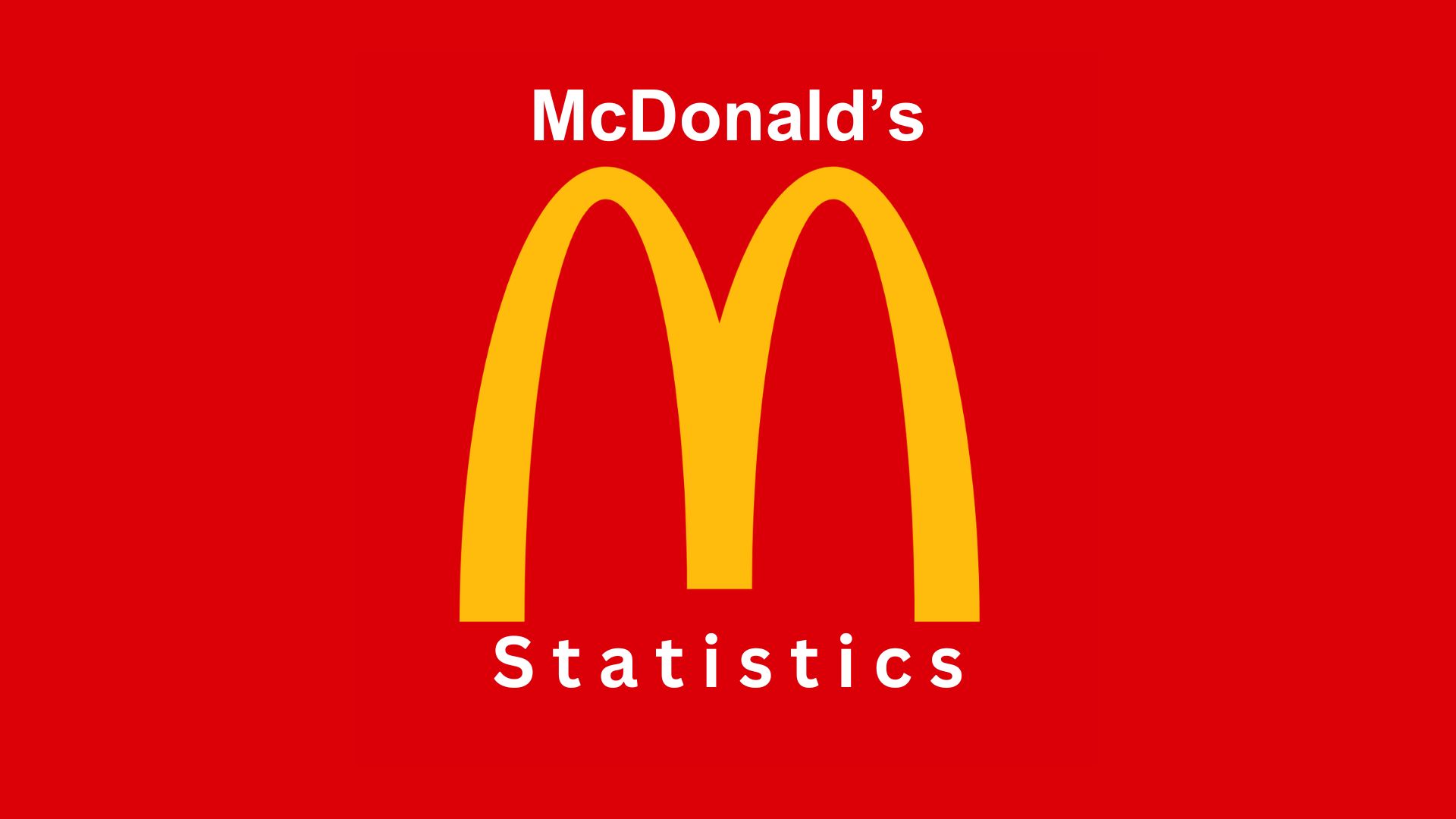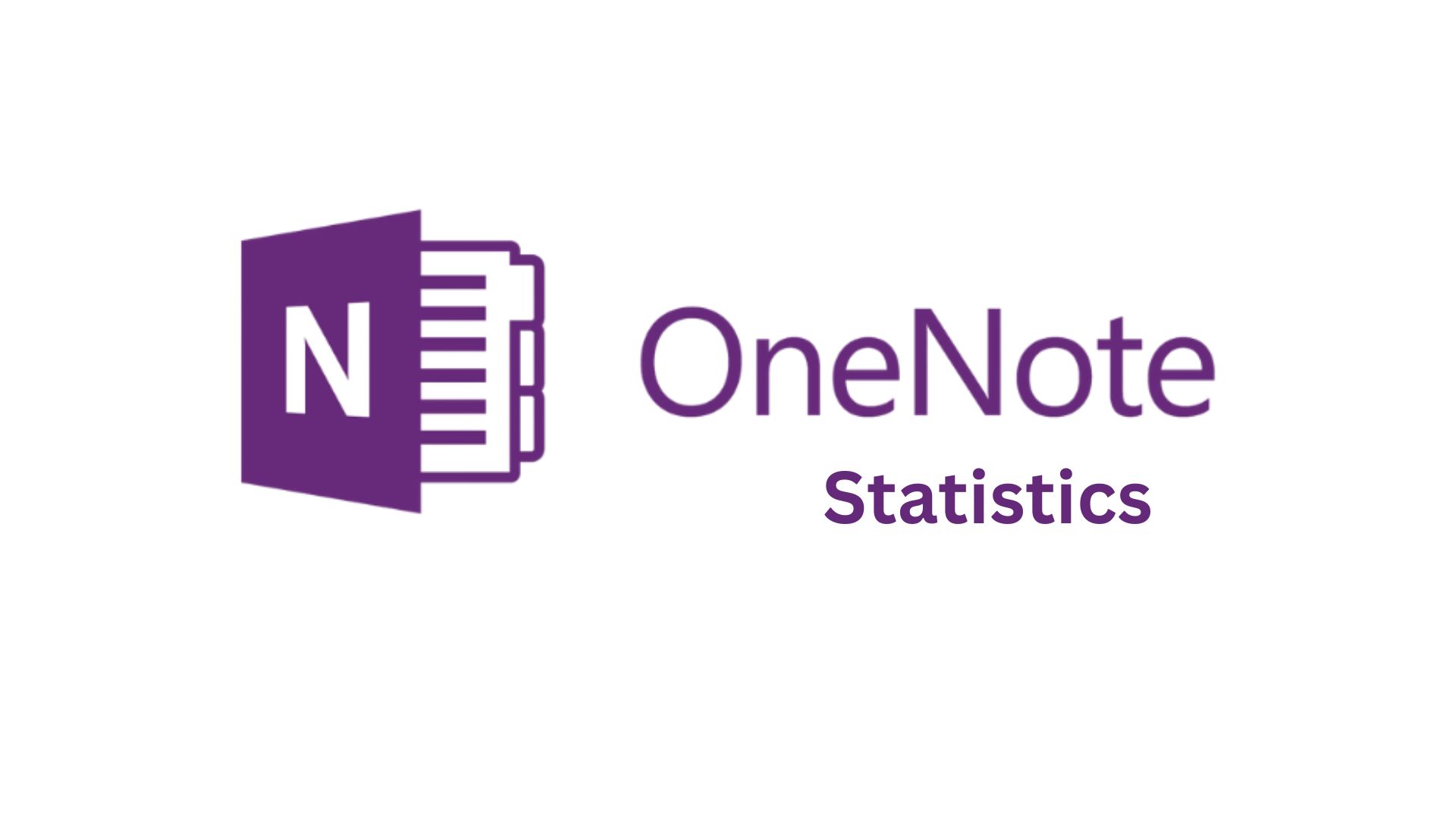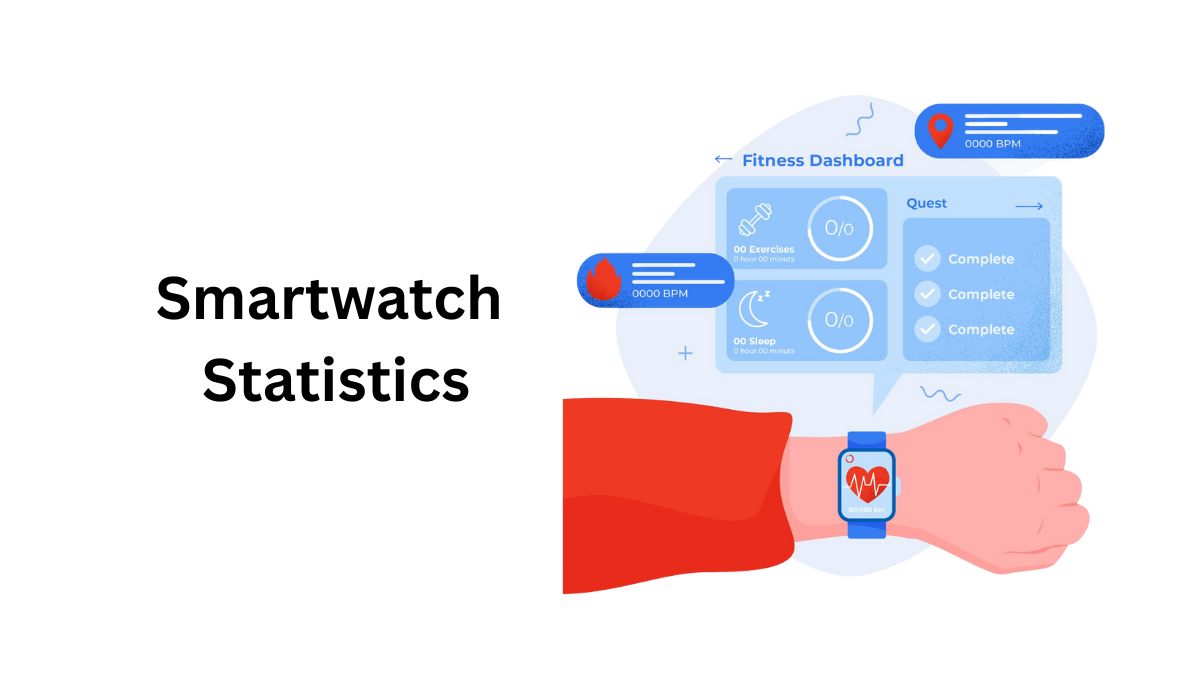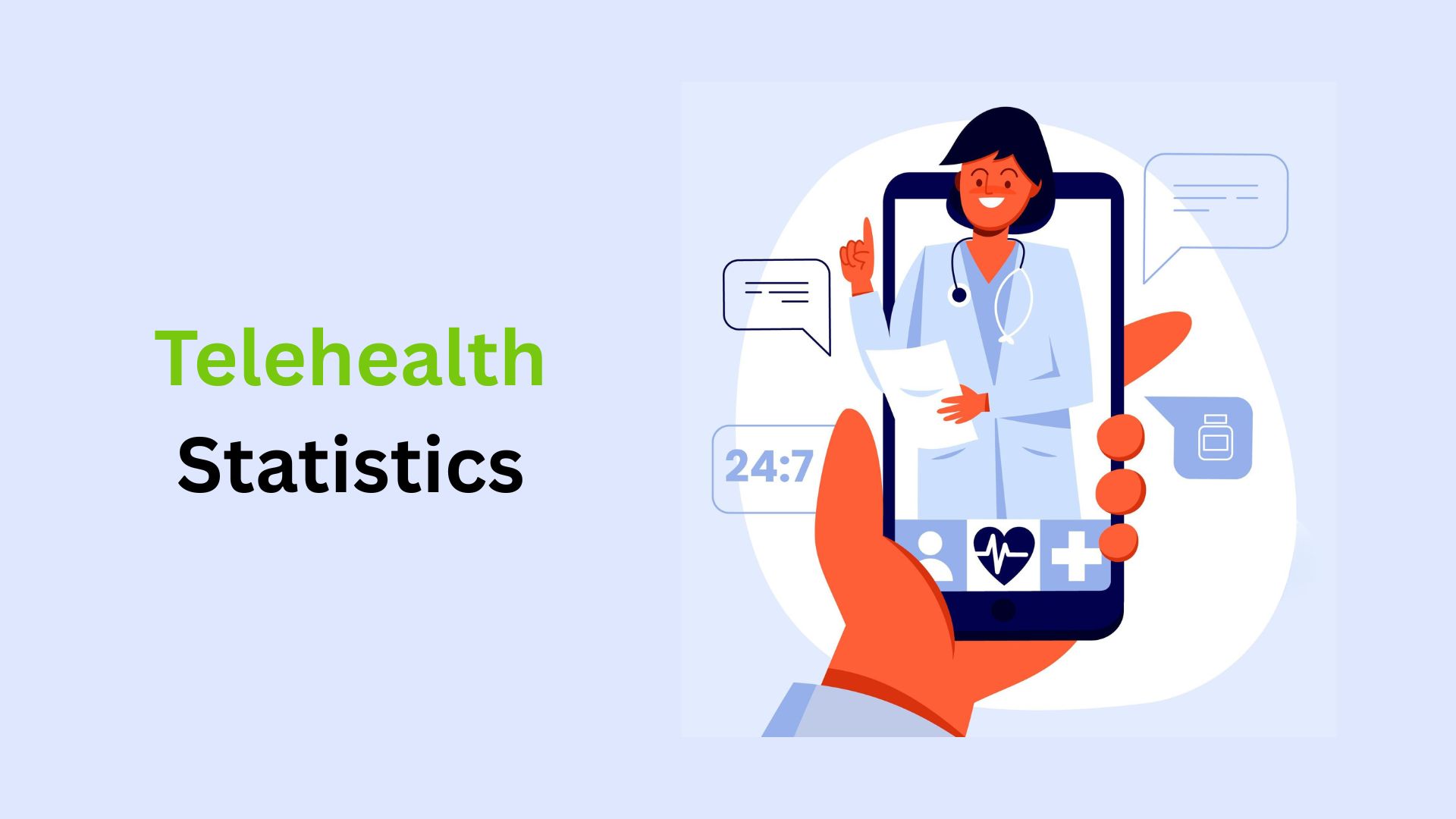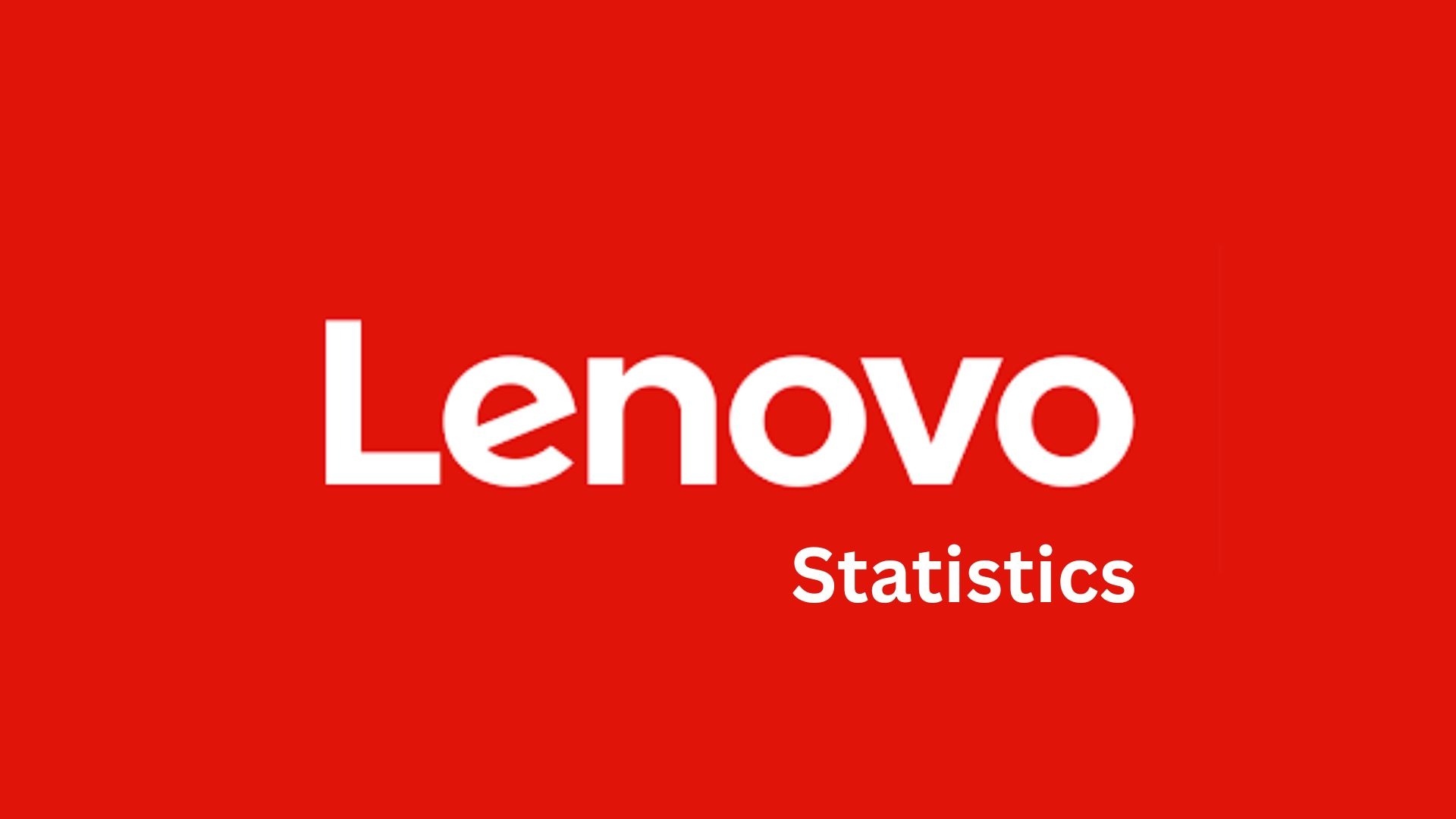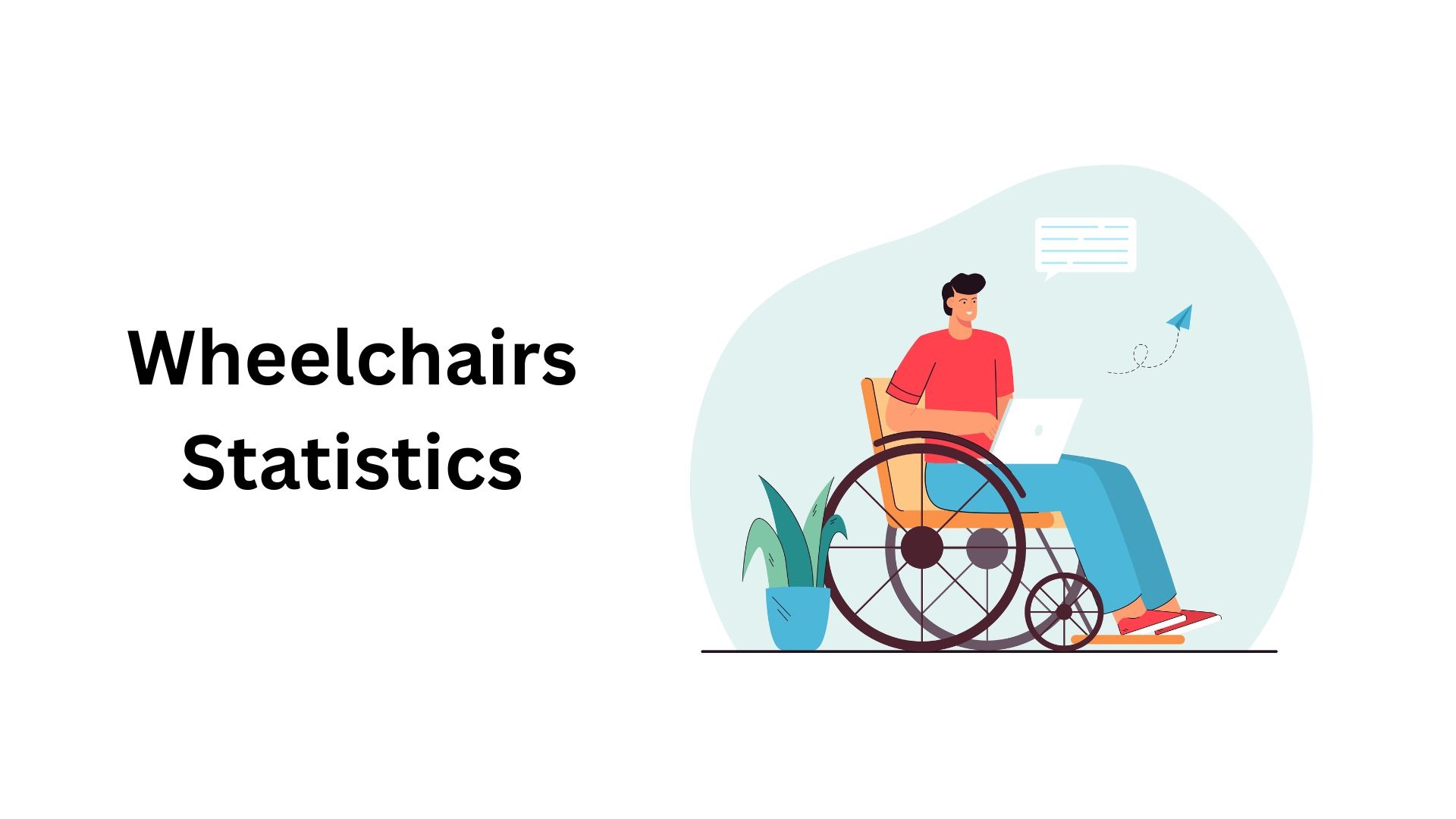Khan Academy Statistics And Facts (2025)
Updated · May 15, 2025

Table of Contents
- Introduction
- Editor’s Choice
- Average Time Spent On Learning Apps In The U.S
- Impact Of Khan Academy And MAP Accelerator On Student Learning Gains
- Effects Of Khan Academy Skills Progress On MAP Growth Score Gains
- Khan Academy Revenue By Segment
- Khan Academy Expenses
- Khan Academy Financial Performance
- Khan Academy Top Donors
- Khan Academy User Statistics
- Khan Academy US District Partnership Programs
- Impact Of Academic Statistics
- Conclusion
Introduction
Khan Academy Statistics: In 2025, Khan Academy continues to be an online education revolution. From a few tutorials on YouTube, the platform, set up by Salman Amin Khan in 2008, has grown into an almost fully-fledged nonprofit learning portal with millions of learners across the globe. Giving free and world-class education-anywhere, anytime-for anyone was so close to Khan Academy’s heart that it greatly shaped the platform’s impact on students learning basic academics, especially mathematics and statistics.
Making statistics accessible through structured lessons, interactive exercises, and real-world applications, Khan Academy tries to demystify this subject, which is often deemed complex and intimidating. In 2024, the Khan Academy statistics course improved, focusing on better content, personalised learning paths, and stronger integration with schools and standardised testing.
Editor’s Choice
- In 2024, students spent around 14 minutes per day on the app, making it the second most widely used educational tool in the United States.
- During the 2022-23 school year, a study of 350,000 students discovered that those who used Khan Academy for at least 30 minutes a week experienced a 20% greater-than-expected learning gain, with an effect size of 0.36.
- Learning gains persisted, though to a lesser degree —about 7%—among students who spent between 9 and 18 hours on Khan Academy.
- Teacher-directed learners use Khan Academy about four times faster than the average U.S. learner, with 60% of the highly engaged learners coming from this group.
- The U.S. Districts Partnerships program witnessed a superb 13% increase in student count, reaching 945,000 students, with 103,000-plus active users (a 40% increase).
- The program caters to a higher percentage of under-resourced students, 64% of whom qualify for free/reduced lunch, 20% being Black and 36% Hispanic.
- In Newark, the District’s Partnerships program has 13 schools with the highest percentage of very active learners (68%) among all partners.
- Khan Academy students demonstrated learning growth of 32% on average, outperforming even pre-pandemic growth levels.
- High school students have an opportunity to earn college credits through Khan Academy, with 98% of students completing the college algebra course and 81% earning college credit.
- In 2023, Khan Academy generated US$107.3 million in revenue, chiefly supported by institutional donors and corporate gifts.
- In 2023, Khan Academy incurred expenses amounting to US$72.5 million, of which 84% was attributed to program services and 16% was funnelled toward General and Administrative costs.
- With major donors including Bill and Melinda Gates Foundation and Beneficus Foundation, Khan Academy has received total donations over US$100 million.
- Khan Academy envisions a target of 5 million students in the U.S. whose learning will be accelerated and whose STEM subject progress will be increased by 50% for 50% of that population.
Average Time Spent On Learning Apps In The U.S
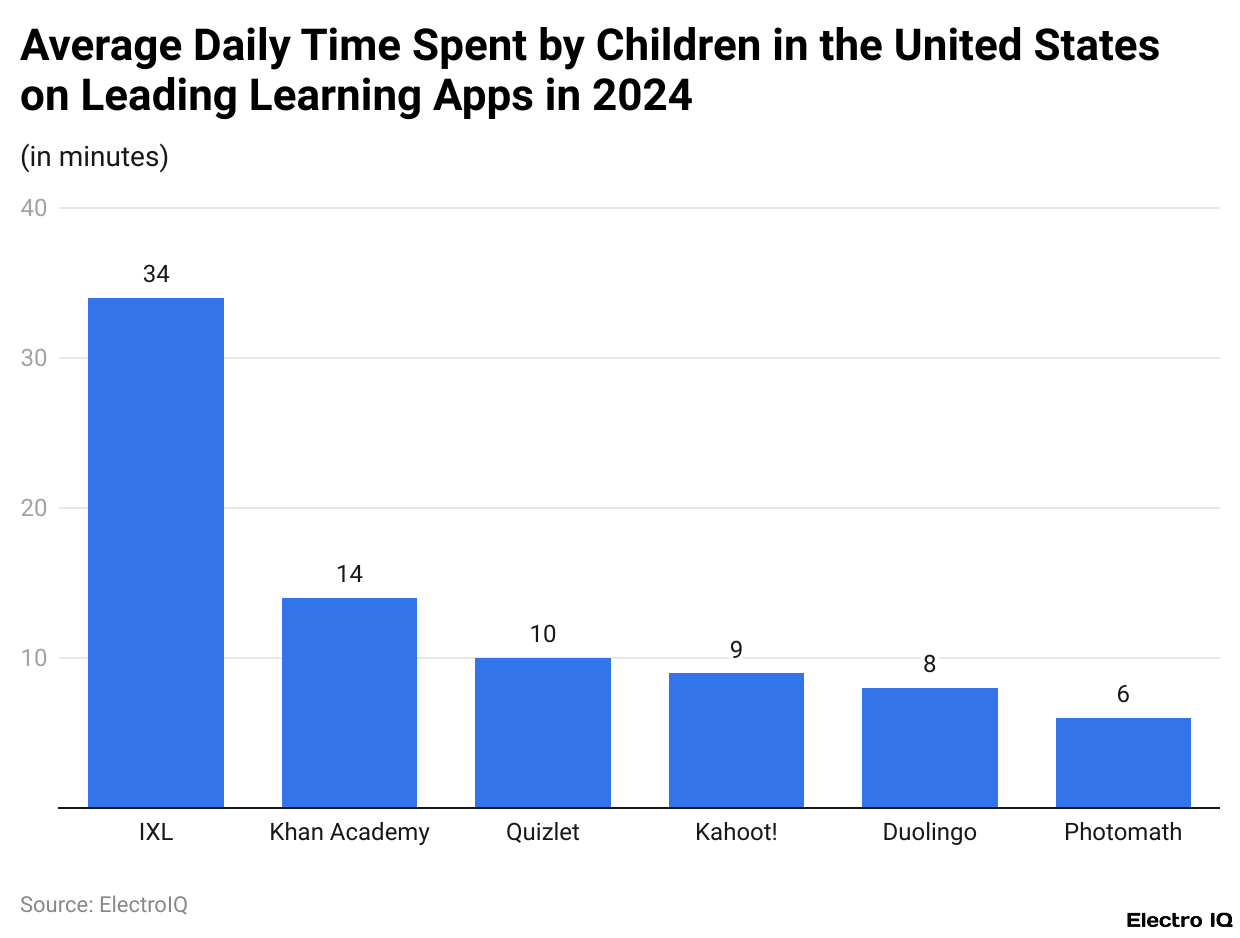
(Reference: statista.com)
- In 2024, U.S. children and young teens allotted differing amounts of time on educational apps and communication platforms.
- The most time was spent on average on an educational app, IXL, at about 34 minutes per day.
- The second most used educational app was Khan Academy, with an average usage of about 14 minutes per day among this age group.
- It was followed by Quizlet, with 10 minutes of daily engagement.
- Contrarily, a lot more time was spent by the kids on social and communication apps.
- Snapchat, with an average of 90 minutes/day, took the highest, followed by Discord with approximately 33 minutes of usage each day.
- These Khan Academy statistics suggest that while educational apps do find their way into kids’ daily routines, entertainment and communication apps dominate their screen time.
Impact Of Khan Academy And MAP Accelerator On Student Learning Gains
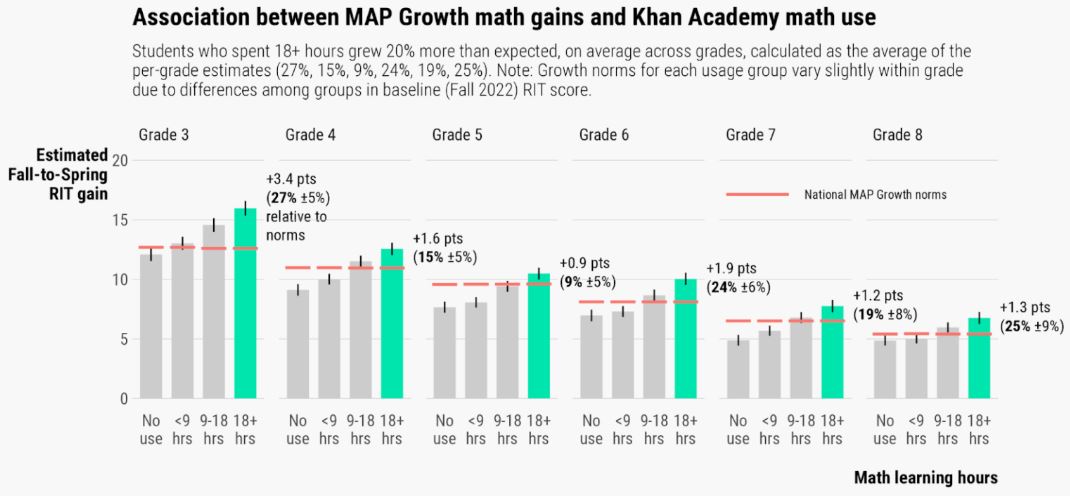
(Source: blog.khanacademy.org)
- In a recent study by Khan Academy, statistics during the 2022–23 school year, the evaluation of about 350,000 students in grades 3 to 8 on the effect of its KAD (Khan Academy Districts) and MAP Accelerator programs was completed.
- The results of the evaluation indicated that students who spent at least 30 minutes per week on the Khan Academy—or 18 hours throughout the school year—gained 20% more-than-expected learning gains, as measured by the MAP Growth Assessment.
- These positive results were observed across various demographic categories.
- Nevertheless, only some 9% of students in the sample, that is, about 33,000 students, reached this level of recommendation for usage.
- Nonetheless, students using Khan Academy less than the recommended amount still appeared to gain much from the learning process.
- For example, some 15% of students (approximately 55,000) who spent 9-18 hours on the platform over a year had learning gains that were about 7% greater than expected.
- The overall effect size for the study came to 0.36, indicating a noticeable impact on student learning.
- This happens through MAP Accelerator, building personal learning pathways for each student, based on their MAP Growth results.
- This adaptive system targets each student’s needs in subjects such as math and reading for academic growth.
Effects Of Khan Academy Skills Progress On MAP Growth Score Gains
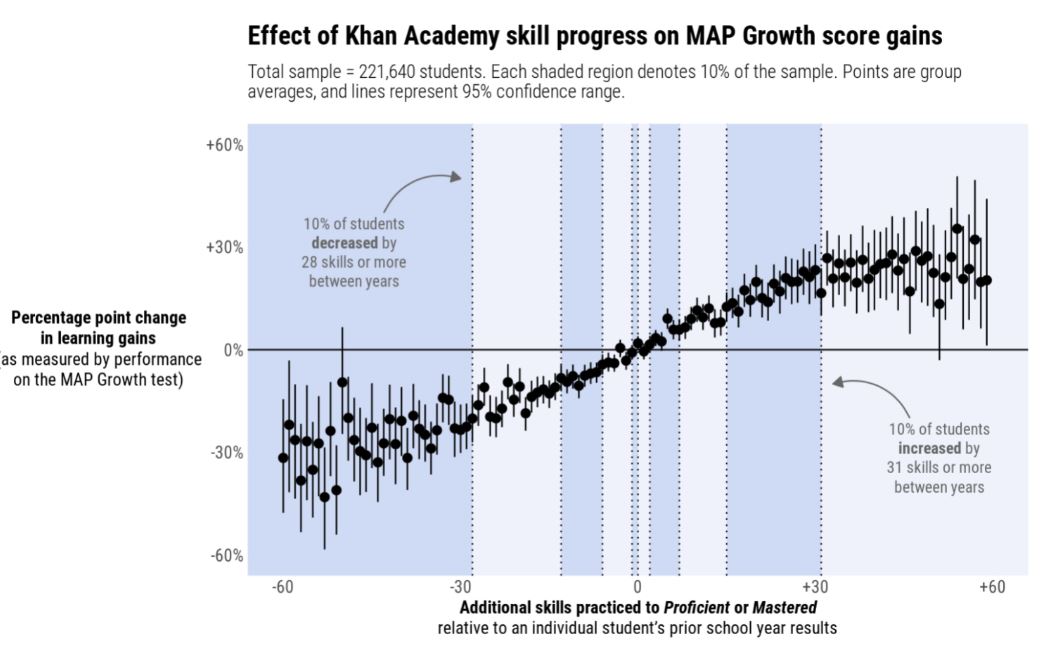
(Source: blog.khanacademy.org)
- Khan Academy has been carrying out this study consecutively over three years, now with data from approximately 221,000 students engaged in the study for two or more years.
- This long-term Khan Academy statistics data brings the researchers’ ability to compare each student to himself or herself over time while largely wiping out the influence of outside factors such as an especially motivated student or an especially good teacher who might sway the results otherwise.
- The greater reliability of the analysis lies in the change within individual students. The longitudinal study tries to relate the change in students’ learning gains from year to year to the extent of their usage of Khan Academy.
- It considers adjustments in academic growth if students increase or decrease the use of the platform. It further examines how students score in MAP Growth tests in relation to the number of new skills they acquire on Khan Academy within a year.
- A student’s skill comprehension for all skills tested on the platform is tracked through intermediate stages: attempted, familiar, proficient, and mastered.
- The stages are achieved by students who answer questions correctly on assessments such as exercises, quizzes, unit tests, or mastery challenges. This method helps to understand how much a student is truly learning each year amid the use of the platform.
- The study found that every additional skill that a student practices to the level of “proficient” or “mastered” brings in a learning gain of roughly half a percentage point (0.5 pp) compared to his or her own performance in the previous year.
- According to Khan Academy statistics, about 52% of the 221,000 students in the sample, approximately 115,000 students, were able to increase the number of skills they were learning to proficient or mastered, and the other 48%, approximately 106,000 students, decreased the skills achieved compared to the prior year.
- Learning gains were observed in students who increased the number of skills learned, while slightly decreased gains were seen in students who lowered the number. Improvement in learning depends on how many more skills a learner attains, either proficiency or mastery of.
- For example, learners who gained 1 to 15 skill masteries-about 30% of the sample, or 66,000 learners-generally demonstrated intermediate learning gains of 5 percentage points.
- About 10% of all students, or maybe 20,000, showed learning gains of about 15 percentage points, and those who gained mastery of 15 to 30 skills showed learning gains of about 15 percentage points.
- About 4% of the learners, or about 9,500, increased their skill count by 60 or more when compared with the previous year.
- These learners generally gained about 30 percentage points in learning, which amounts to an overall increase of 20% to 30%.
Khan Academy Revenue By Segment
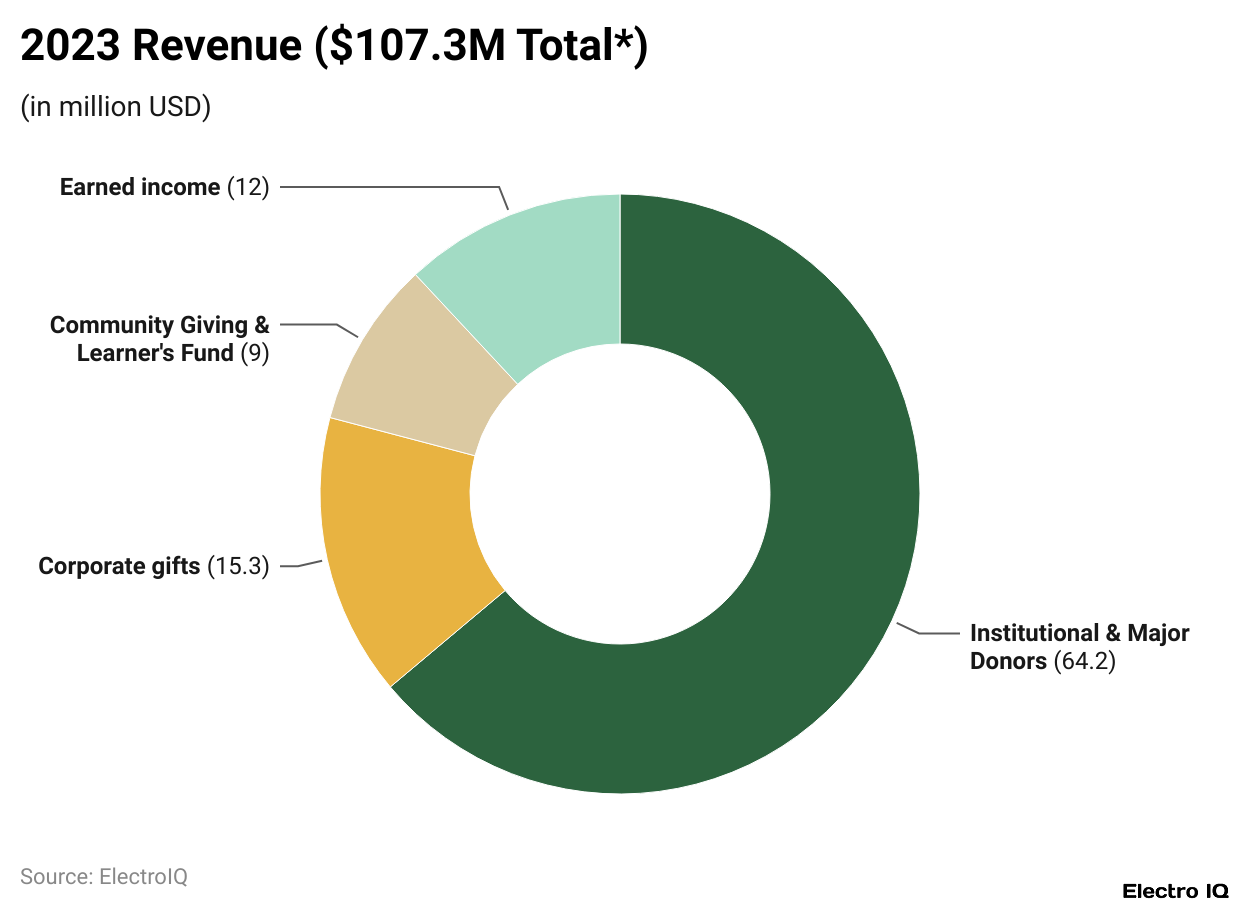
(Reference: annualreport.khanacademy.org)
- Khan Academy statistics generated revenues of US$107.3 million in 2023. During 2023, US$64.2 million came from institutional and major donors.
- Corporate gifts gave another US$15.3 million, with community giving and gifts to the Learner’s Fund contributing US$9 million.
- Khan Academy also made about US$12 million from income-generating activities like partnerships or services.
- This diversity of financing sources supports Khan Academy’s work in providing free, quality education to learners all over the world.
Khan Academy Expenses
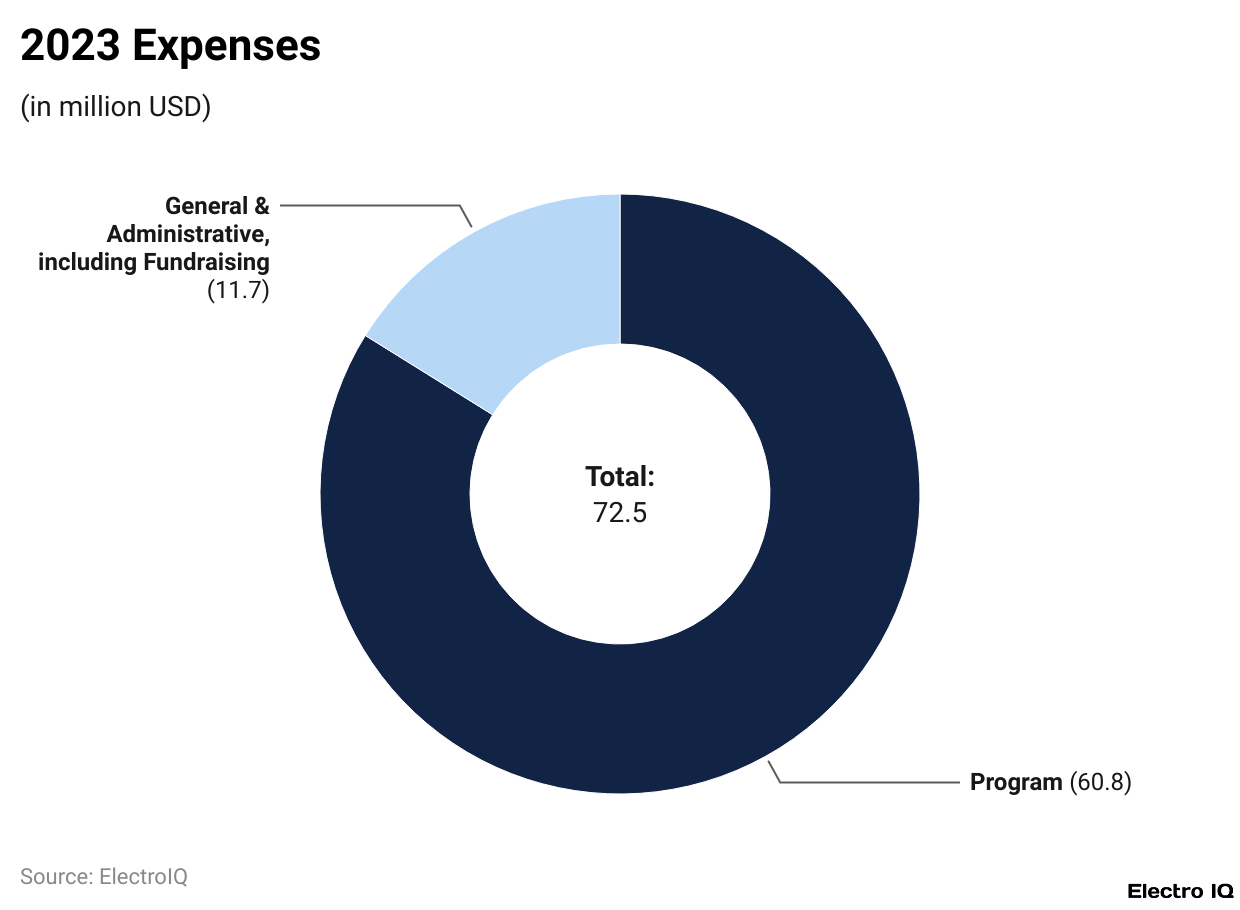
(Reference: annualreport.khanacademy.org)
- In 2023, Khan Academy reported expenses totalling US$72.5 million, with US$60.8 million, or about 84% of the total, going directly toward program-related activities, such as developing educational content, maintaining the learning platform, and assisting engagement among students and teachers.
- Typically, the remaining US$11.7 million, about 16%, would be spent on general and administrative expenses, including fundraising.
- This hardly leaves any room for doubt that most of its expenditures go into the program side of Khan Academy—the whole core mission of delivering free, high-quality education to learners in all four corners of the world.
Khan Academy Financial Performance
- Khan Academy’s funding comes from a mixture of charitable contributions, program services, and investment income. Total assets amount to US$105.26 million, while liabilities stand at approximately US$11.53 million.
- Thus, its net assets amount to nearly US$93.72 million. Of its revenues, the greatest share—from foundation and individual donors alone—stands at 75.1%.
- Khan Academy has confirmed receiving contributions from charitable foundations exceeding US$39.98 million in recent years: US$21.1 million from foundations and individual gifts and US$18.8 million from corporate funders.
- Another 24.3% of Khan Academy’s revenues are derived from program services, amounting to US$12.92 million.
- Investment income amounts to US$1.39 million, forming the other 2.6%.
- On budget expenditure, the organisation uses 55.7% of its budget on salaries and wages of non-executives.
- Executive salaries form 7.4% of the expenditures, with founder and CEO Salman Khan drawing in excess of US$1.2 million.
- These Khan Academy statistics figures show a strong financial foundation of the platform; in other words, it is highly dependent on donor support, with many expenses going toward the education workforce.
Khan Academy Top Donors
| Grantmaker |
Total Amount Donated to Khan Academy
|
| Bill and Melinda Gates Foundation | $38,146,758 |
| The Beneficus Foundation | $19,781,219 |
| Silicon Valley Community Foundation | $12,612,400 |
| Windsong Trust | $10,860,000 |
| Valhalla Foundation | $7,024,962 |
| Musk Foundation | $7,000,000 |
| The Amgen Foundation, Inc. | $6,700,000 |
| Osullivan Foundation Trust | $6,580,250 |
| Omidyar Network Fund, Inc. | $6,505,000 |
| Overdeck Family Foundation, Inc. | $6,254,300 |
(Source: learnopoly.com)
- Several large grantmakers have supported Khan Academy over the years. The largest philanthropist: the Bill and Melinda Gates Foundation, with US$38,146,758 given in total.
- After that, Beneficus Foundation has contributed US$19,781,219, while the Silicon Valley Community Foundation has donated US$12,612,400.
- Next in line, Windsong Trust gave away US$10.86 million. Others have gifted US$7,024,962 from the Valhalla Foundation and US$7 million from the Musk Foundation.
- The Amgen Foundation, Inc. provided US$6.7 million, while the Osullivan Foundation Trust gifted US$6,580,250.
- Omidyar Network Fund, Inc. contributed US$6,505,000, and the Overdeck Family Foundation, Inc. gave US$6,254,300.
- Such donated funds express strong philanthropic support for Khan Academy from both tech-focused and education-oriented foundations.
Khan Academy User Statistics
- According to Khan Academy statistics, in 2025, the platform enjoyed tremendous global popularity, with 120 million learners using it annually and 13.7 million new learners joining in that year.
- Between 2022 and 2025, 718,000 parents and 490,000 new teachers also engaged with the platform. In terms of engagement, learners spent 7.7 billion minutes on the platform combined in 2025.
- The Districts Program of Khan Academy has witnessed 13% year-on-year growth, impacting 945,000 children in the United States.
- Of these, the number of “Very Active Learners”, or those spending at least 18 hours per year on Khan Academy, has risen 40% year-over-year, mainly due to district partnerships.
- Grassroots teachers, in other words, those who advocate for and use the platform on their own, account for only about 4% of all registered users.
- With this, Khan Academy’s near-future vision boldly envisions accelerating the learning of 10% of all U.S. students (approximately 5 million learners every year) by increasing their progress in STEM by 50%.
- This is another step toward fulfilling its commitment to educational equity and excellent education.
Khan Academy US District Partnership Programs
- According to Khan Academy statistics, in the 2022-23 school year, there occurred a 13% increase in students licensed to use Khan Academy through the Districts Partnership program, amounting to 945,000 students.
- Very active users also recorded a large growth in the program’s number, at 40%, to over 103,000 students.
- The Khan Academy Districts Partnerships program consists of proportionally more students from under-resourced populations than the national average.
- About 64% of the students in this program qualify for free or reduced lunches, which is more than the national average of 61%.
- Another group with greater representation in the program than in the nation comprises Black students at 20% versus 15%, along with Hispanics at 36% versus 28% nationally.
- The District’s Partnerships program works with 13 Newark schools, where it has established impressive results.
- The Newark School District presents itself with the highest percentage of very active learners (68%) among all Khan Academy district partners.
- This district has 6,000 math students participating in the program, and over 560 educators support them.
- The demographics of the Newark program mirror the city population, with 55% of participating students being Hispanic, 35% Black, and 70% low-income.
Impact Of Academic Statistics
- More than 50 studies have been carried out to prove that Khan Academy has been useful in enhancing learning outcomes.
- According to recent statistics from Khan Academy, Dylan performed on behalf of Khan Academy. Students who had used the site for over 30 minutes per week could externally achieve an average growth of 32%, outpacing the pre-pandemic growth levels.
- The growth was according to grade levels and ranged from 26 to 38%.
- Students who had used the site for less than 30 minutes per week experienced learning growth as well.
- In terms of engagement, teacher-assisted learners have reached efficacy rates four times faster than the average U.S. learner when compared to learners who bought Khan Academy on their own.
- These were indeed fewer in number, but this small group constituted about 60% of the most engaged learners, called “efficacious learners.”
- However, students who participated in the U.S. Districts Partnerships program reached efficacy usage rates 10 times faster than the average learners.
- It may become more probable that these learners graduate from college and earn a pretty penny in return, since Khan Academy helps high school graduates earn college credits and skip remedial math lessons.
- Results from the credential system’s pilot phase reveal that 98% of students who were initiated in the college algebra course on the platform have completed it, while 81% of those who have completed the course were eligible for college credit.
Conclusion
Khan Academy Statistics 2024 stands out as an example of how technology applied toward a mission can aim to make education equal. With a mixture of structured learning, emphasis on real-world application, and AI-assisted tutoring, the academy has brought an understanding of statistics to millions of people: one of the most important skills required in today’s data-driven environment.
By respecting accessibility and quality, Khan Academy encourages anyone to learn any subject for free, at any time or from anywhere, no matter how difficult it is. Whether you are a high school student, a college learner, or an adult with some curiosity, Khan Academy Statistics-2024 is a stand-alone inspirational learning tool.
FAQ.
In 2024, U.S. children recorded an average of 14 minutes daily on Khan Academy, making it the second-favourite educational app of children and young teens in the U.S.
According to a study during the 2022-2023 school year, students who used Khan Academy for at least 30 minutes weekly experienced 20% greater than expected-larger gains in learning, as measured by the MAP Growth Assessment.
Khan Academy enables high school students to earn college credits through the courses it offers. For example, 98% of the students who passed Khan Academy’s college algebra course received actual college credit, which might exempt them from taking remedial math and increase their graduation prospects.
Khan Academy’s Districts Partnerships program has impacted 945,000 students in the 2022-2023 school year with massive growth in “very active learners” (learners that spend 18 or more hours meaningfully engaged in the platform per annum). This program mostly targets under-resourced students to close educational gaps.
In the year 2023, the platform generated US$107.3 million in revenue. Mostly, funding came from institutional donors and corporate gifts. Other streams of income include partnerships and services that enable the platform to provide free, high-quality education to the entire world.

Pramod Pawar brings over a decade of SEO expertise to his role as the co-founder of 11Press and Prudour Market Research firm. A B.E. IT graduate from Shivaji University, Pramod has honed his skills in analyzing and writing about statistics pertinent to technology and science. His deep understanding of digital strategies enhances the impactful insights he provides through his work. Outside of his professional endeavors, Pramod enjoys playing cricket and delving into books across various genres, enriching his knowledge and staying inspired. His diverse experiences and interests fuel his innovative approach to statistical research and content creation.

